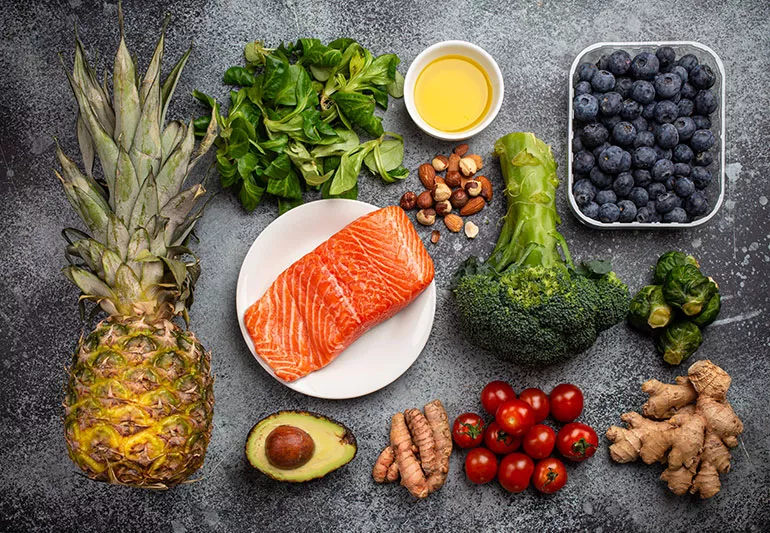Beyond the Hype: What Science Really Says About Food as Medicine
You’ve probably seen the headlines: “This superfood will cure your inflammation!” or “One simple trick doctors don’t want you to know!” While the internet is flooded with miracle food claims, the reality is both more nuanced and more hopeful. As someone who works with patients recovering from injuries and chronic pain, I’ve seen firsthand how the right foods can genuinely support the healing process—and how the wrong ones can sabotage it.
Let’s cut through the noise and explore what actually works.
The Food-Inflammation Connection: Why It Matters
Your kitchen isn’t a pharmacy, but it’s not far off. Every meal you eat either fans the flames of inflammation or helps put out the fire. Here’s the science simplified:
When you eat certain foods, they trigger biochemical reactions in your body. Some foods promote the production of inflammatory compounds like prostaglandins and cytokines. Others provide the raw materials your body needs to create anti-inflammatory molecules and repair damaged tissues.
The Inflammation Hall of Fame: Foods That Actually Help
1. Fatty Fish – Your Omega-3 Powerhouse
The stars: Salmon, mackerel, sardines, anchovies, and herring
Why they work: These fish are loaded with EPA and DHA, omega-3 fatty acids that your body converts into specialized molecules called resolvins and protectins. These literally help “resolve” inflammation and promote tissue repair.
The realistic dose: 2-3 servings per week. That’s about 6-8 ounces total—think a small salmon fillet twice a week.
Pro tip: Wild-caught is ideal, but don’t let perfect be the enemy of good. Even farm-raised fish provides beneficial omega-3s.
2. Leafy Greens – Nature’s Multivitamin
The stars: Spinach, kale, arugula, Swiss chard, and collard greens
Why they work: Packed with vitamins K, C, and E, plus compounds like quercetin and kaempferol that directly inhibit inflammatory pathways.
The realistic dose: Aim for 2-3 cups of leafy greens daily. That could be a big salad at lunch or a handful of spinach in your morning smoothie.
Real talk: Frozen is fine! Frozen greens often have higher nutrient content than “fresh” greens that have been sitting around for weeks.
3. Berries – Small But Mighty
The stars: Blueberries, strawberries, blackberries, and cherries
Why they work: Rich in anthocyanins, the compounds that give berries their deep colors. These powerful antioxidants reduce inflammatory markers and support cellular repair.
The realistic dose: 1/2 to 1 cup daily. Mix them into yogurt, oatmeal, or eat them as snacks.
Special mention: Tart cherry juice has been specifically studied for reducing exercise-induced inflammation and improving recovery in athletes.
4. Turmeric – The Golden Anti-Inflammatory
The star compound: Curcumin
Why it works: Curcumin inhibits multiple inflammatory pathways simultaneously, including COX-2 and lipoxygenase enzymes.
The catch: Curcumin has poor absorption on its own. You need to pair it with black pepper (which contains piperine) and consume it with fat for optimal absorption.
The realistic dose: 1-2 teaspoons of turmeric powder daily, or consider a curcumin supplement with added piperine.
Practical tip: Golden milk (turmeric latte) or adding turmeric to curries, soups, and rice dishes.
5. Extra Virgin Olive Oil – Liquid Gold
Why it works: Contains oleocanthal, a compound with similar anti-inflammatory effects to ibuprofen (though much milder). Also rich in vitamin E and healthy monounsaturated fats.
The realistic dose: 2-3 tablespoons daily as your primary cooking oil or salad dressing.
Quality matters: Look for cold-pressed, extra virgin olive oil in dark bottles. The cheaper, refined versions won’t have the same benefits.
6. Nuts and Seeds – Portable Powerhouses
The stars: Walnuts, almonds, flaxseeds, and chia seeds
Why they work: Rich in omega-3 fatty acids, vitamin E, and magnesium—all crucial for managing inflammation and supporting tissue repair.
The realistic dose: A small handful (about 1 ounce) daily. That’s roughly 12-15 almonds or 6 walnut halves.
Pro tip: Walnuts are particularly high in alpha-linolenic acid (ALA), a plant-based omega-3.
The Inflammation Hall of Shame: Foods That Work Against You
Being honest about what hurts is as important as knowing what helps:
Ultra-Processed Foods
Think packaged snacks, fast food, and anything with a long ingredient list you can’t pronounce. These foods often contain trans fats, excessive omega-6 oils, and chemical additives that promote inflammation.
Excess Sugar
Particularly high-fructose corn syrup and added sugars in sodas, candies, and baked goods. Sugar spikes trigger inflammatory pathways and interfere with immune function.
Refined Carbohydrates
White bread, white rice, and pastries cause blood sugar spikes that promote inflammatory responses.
Excessive Omega-6 Oils
While omega-6 fats aren’t inherently bad, the modern diet often contains too many (from vegetable oils like corn, soy, and sunflower oil) and too few omega-3s, creating an inflammatory imbalance.
Building Your Anti-Inflammatory Plate
Instead of obsessing over individual foods, think about patterns:
The Mediterranean Model: This eating pattern consistently shows up in research as one of the most anti-inflammatory approaches. It emphasizes:
- Fish and seafood 2-3 times per week
- Plenty of vegetables and fruits
- Whole grains over refined ones
- Olive oil as the primary fat
- Nuts and seeds regularly
- Limited processed foods
The 80/20 Rule: Aim for anti-inflammatory choices 80% of the time. The occasional pizza or ice cream won’t derail your progress, but consistency with healing foods will make a difference.
What to Expect: Realistic Timelines
Week 1-2: You might not feel dramatically different yet, but blood markers of inflammation often start improving.
Week 3-4: Many people report better energy levels and improved sleep quality.
Month 2-3: This is when you might notice reduced joint stiffness, better recovery from exercise, or less frequent flare-ups of chronic conditions.
Remember: Food is powerful medicine, but it works slowly and subtly. Don’t expect overnight miracles, but do expect gradual, sustainable improvements.
Your Anti-Inflammatory Action Plan
Anti-inflammatory eating isn’t about perfection or expensive superfoods. It’s about consistently choosing whole, minimally processed foods that provide your body with the tools it needs to heal itself.
Your plate should be colorful, your fats should be healthy, and your approach should be sustainable. Small, consistent changes trump dramatic overhauls that you can’t maintain.
Start simple: Add a handful of berries to your breakfast, swap your cooking oil for olive oil, and include fish in two meals this week. Your body—and your recovery—will thank you.
Looking to optimize your nutrition for faster healing and better health? Consider consulting with both a registered dietitian and your healthcare provider to create a personalized plan that supports your specific health goals and conditions.





